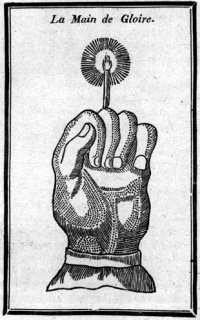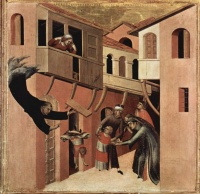Horror
From The Art and Popular Culture Encyclopedia

![Noble and Ignoble Grotesque from the The Stones of Venice "Objects which in themselves we view with pain, we delight to contemplate when reproduced with minute fidelity: such as the forms of the most ignoble animals and of dead bodies" --Aristotle, Poetics [...].](/images/thumb/200px-Noble_and_Ignoble_Grotesque_from_John_Ruskin's_Stones_of_Venice_(1851-1853)..jpg)
"Objects which in themselves we view with pain, we delight to contemplate when reproduced with minute fidelity: such as the forms of the most ignoble animals and of dead bodies" --Aristotle, Poetics [...].

|
Related e |
|
Featured: |
Horror is an intense painful emotion of fear or repugnance; an intense dislike or aversion, an abhorrence. It is also a genre of fiction, meant to evoke a feeling of fear and suspense. The horrors, informal, also refers to an intense anxiety or a nervous depression.
Horror may mean:
- Horror (emotion), the physical and mental sensation
- Horror art, art focusing on horror themes
- Horror fiction, the general genre
- Horror film, the genre in film
Contents |
Horror tropes
Horror as a genre started with gothic fiction. Its tropes include terror (both psychological and physical), mystery, the supernatural, ghosts, haunted houses and Gothic architecture, castles, darkness, death, decay, doubles, madness, secrets and hereditary curses.
Stock characters
The stock characters of gothic fiction include tyrants, villains, bandits, maniacs, Byronic heroes, persecuted maidens, femmes fatales, madwomen, magicians, vampires, werewolves, monsters, demons, revenants, ghosts, perambulating skeletons, the Wandering Jew and the Devil himself.
Modern subgenres
Modern subgenres and tropes include bio horror - body horror - carnivorous plants - Count Dracula - erotic horror - exploitation - fantastic - Frankenstein - freaks of nature - gore - ghost - gothic fiction - grindhouse - horticultural horror - magic - Mondo film - monster - phantom of the opera - psychological horror - slasher films - snuff films - vampire - video nasty - werewolf - zombie
Related vocabulary
Related vocabulary includes terms such as bizarre - blood - controversial - cruelty - dark - death - demon - devil - disgusting - disturbing - evil - fantasy - fear - gothic - grotesque - hidden - inquisition - macabre - midnight - night - occult - offensive - pain - phobia - prison - repugnance - secret - shocking - sadism - sick - strange - sublime - supernatural - surreal - terror - torture - ugly - uncanny - violence - visceral - war
Etymology
From Latin horror (“a bristling, a shaking, trembling as with cold or fear, terror”), from horrere (“to bristle, shake, be terrified”).
See also



